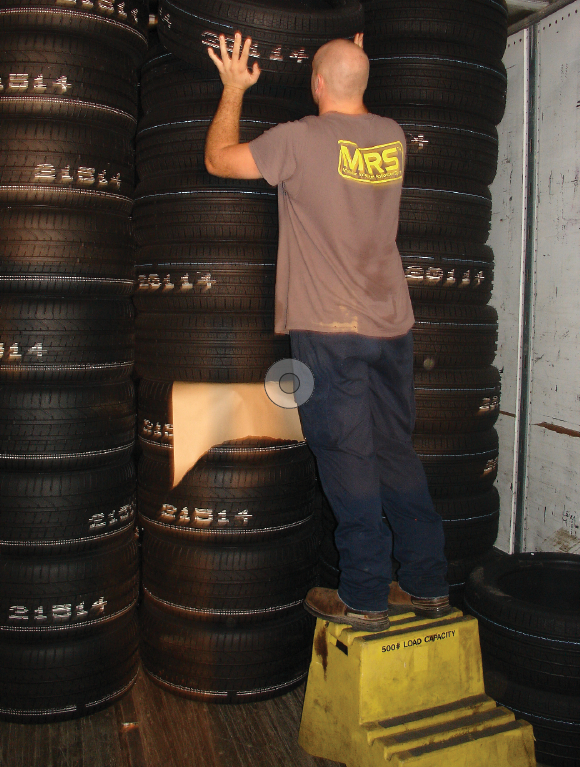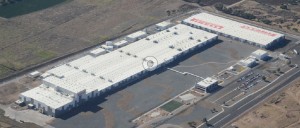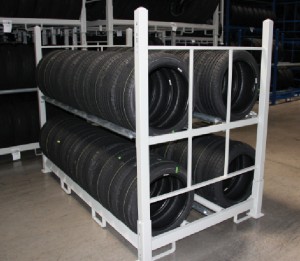 A shift towards local production and increased near-sourcing is improving the tyremaker’s logistics and order management in one of its main growth territories, reports Anthony Coia
A shift towards local production and increased near-sourcing is improving the tyremaker’s logistics and order management in one of its main growth territories, reports Anthony Coia
Based in Milan, Italy, Pirelli & C SpA is the world’s fifth largest tyre manufacturer, with 22 factories in 13 countries around the world. While it is currently expanding in a number of locations, including Asia, one of its fast growing markets for both OEM and replacement tyre sales is North America.
The tyremaker has subsequently increased its production of tyres within North America – a measure that has improved its customer service rate significantly, while also reducing logistics costs. The opening of a second plant in the region – in Silao, Mexico during 2012 – has been a watershed for its logistics in North America, leading to more regional tyre production, growth in local souring and speedier lead times.
John Godfrey, vice-president of logistics and purchasing at Pirelli Tire North America, says the company has shifted to more land-based transport, especially intermodal. At the same time, he notes an obvious need to expand logistics capacity, from truck drivers to warehouses and rail transport.
In response to changes in the North American market, Pirelli has also been re-engineering its logistics services around more direct deliveries and faster response times, as well as seeking more opportunities for intermodal transport out of Mexico. For retail customers in both the US and Canada, in particular, Pirelli is experiencing higher demand for smaller and more frequent deliveries, including next day and second-day delivery.
Increased sourcing within North America is also helping to improve Pirelli’s logistics cost and delivery performance. For example, with the increase in Pirelli’s Mexican production capacity and exports to the US, overseas container ocean imports have decreased relative to overland imports. “Due to the reduction of transit time and its associated risks, this change has helped to increase our replacement tyre customer fill rates from 60% to 85%, which is a significant improvement,” says Godfrey.
Going for local
Within the NAFTA region, Pirelli has tyre plants in Rome, Georgia – near Atlanta – and in Silao, 350km northwest of Mexico City. The company serves two primary distribution channels with its finished products: OEMs, for vehicle production; and the replacement tyre segment for the aftermarket. In the last few years, Pirelli has seen strong sales growth in both the retail and OEM segments of the market in North America, with both local production and exports beyond North America also on the increase. This year, the tyremaker also expects close to double digit growth compared to 2013 sales.
Pirelli’s tyre sales of approximately $871.4m in North America last year accounted for 11% of its global sales.
Despite the expansion in regional production in North America, Pirelli still imports most of its tyres from overseas – still about double the amount compared to regional production. However, output at Silao has grown exponentially, from 400,000 units in 2012 to 1m last year, and 3.5m expected by 2015 when the plant reaches its current capacity.
Prior to its Mexico plant, however, the company imported more than 90% of finished tyres in the region. Most finished tyre imports arrive in the NAFTA region by ocean container from overseas destinations including Brazil, China, Romania, and Germany.
The company also has a large share of its raw material suppliers in Europe and Asia. For the Silao plant, the majority of the rubber used in production is from Southeast Asia, although the tyremaker is trying to develop more regional suppliers. “We are working to develop suppliers of natural rubber in Mexico and Guatemala. We are also looking at the possibility of sourcing carbon black – a key ingredient in tyre production – from Mexico as well as China,” says Godfrey. “Our desire is to have everything in North America.”
"We are working to develop suppliers of natural rubber in Mexico and Guatemala... and carbon black from Mexico. Our desire is to have everything in North America" - John Godfrey, Pirelli Tire North America
Another factor is the potential re-introduction of tariffs on Chinese tyre imports to the United States. If implemented, a tariff as high as 90% would make it very expensive to import Chinese tyres, and would likely require a change in sourcing.
Network points
Both North American and imported finished tyres currently move through seven distribution centres in North America. In the US, there is Rome and McDonough, Georgia, and Fontana, California, two of which are operated by Kuehne + Nagel. In Canada, Pirelli has warehouses in Brampton, Ontario and in Vancouver, British Columbia, operated by Kuehne + Nagel and DB Schenker, respectively. In Mexico, its facilities are in Silao and Mexico City. Godfrey indicates that an upcoming tender may well result in another warehouse in the US midwest or northeast.

From Pirelli’s Georgia plant, approximately 60% of finished tyres are destined to OEM plants, with the majority going to Mercedes-Benz and BMW, as well as to Chrysler and Ford.
From Mexico to the US, Pirelli mainly uses Kansas City Southern Railway through Texas, then ships to its warehouse in McDonough. Ocean freight coming to McDonough arrives at the ports of Savannah, Georgia and Charleston, South Carolina. For its Fontana warehouse, it uses the ports of Los Angeles and Long Beach, and for Brampton, it uses Montreal, Vancouver, and Philadelphia, primarily.
Looking to go direct
Especially with the increase in Mexican production, Pirelli is aiming to maximise its direct delivery volumes to North American customers. Godfrey says it ships directly from its Rome plant to its OEM customers whenever possible. In August, Pirelli also began shipping directly from its Silao plant to Ford’s Flat Rock, Michigan plant.
However, not all plant production in the US moves directly to customers, as US-built tyres are consolidated with imports. “We do not ship directly to Mercedes-Benz [in Alabama] or BMW [in South Carolina] from our plant,” says Godfrey. “Many of their tyres come from the UK, Germany, Romania, and Mexico. Thus, we will build trucks with multiple sequenced SKUs at our McDonough warehouse.”
On the other hand, imports can also move directly to customers from ports in some instances.Some of Pirelli’s replacement tyre volume ships from overseas factories directly to its US customers’ distribution centres, while most heads to Pirelli’s warehouses.
“We strive to balance costs with service levels, particularly for some of our retail customers that are more demanding about transit times compared to wholesalers and distributors that receive non-critical full truckload deliveries,” he says.
Speed often matters most for Pirelli’s aftermarket business, so there is the most effort to increase direct delivery for replacement tyres, including more next-day delivery and expedited, less-than-truckload delivery. “Our customers are looking more for same-day or next-day delivery,” says Godfrey. “It is a much shorter cycle time for retailers. Therefore, we are pushing more and more business to retailers rather than wholesalers.”

To further increase its direct delivery for replacement tyres, Pirelli introduced its ‘Tier 1’ programme in 2012, which is a ‘make-to-order’ system for delivering replacement tyres to both Dealer Tire and another retailer, Tire Rack. “Especially with our Tier 1 programme, we maximise direct deliveries from the plants to the customers,” says Godfrey.
The Tier 1 programme also helps to reduce warehouse and pipeline inventories as it includes the company’s ‘collaborative planning forecasting and replenishment system’, which is an important part of the company’s logistics system. Godfrey says Pirelli hopes to expand its Tier 1 initiative to other North American customers. “In order to expand the programme, we must have sufficient volume to ship from one plant to one customer distribution centre. It could be one container per month,” he explains.
A push for more trucks and intermodal
Pirelli’s production and OEM customer growth in Mexico has led to changes in its logistics services, and particularly to a need for more transport capacity. Noticeably, the company is using a higher share of intermodal transport from Mexico to the US, a mode Godfrey would like to use more of where possible. Currently, these flows move about 75% by intermodal container and 25% by truck.
Packaging is critical to making tyre transport both efficient and safe. Generally, passenger and light truck tyres require special pallets or racks. “Upgrading the pallets in a warehouse is a significant investment for the company. We make sure to maintain the correct pallet design in our warehouses, including modifying some pallet designs for specific markets,” says John Godfrey.

It is vital to have the correct pallet and protection so as not to damage the tyre. Pirelli also needs make the most use of its warehouse space, while reducing handling. “We are currently investing in new pallets in the NAFTA region and globally we are working to design an optimal pallet for our tyres that uses specialised steel and plastic,” Godfrey says. “Since our product portfolio has been shifting more toward premium tyres, which means larger diameter products, our racking needs aim to accommodate these more effectively.”
There are also some opportunities to use larger racks. In Canada, for example, some of Pirelli’s deliveries are on racks that fit into 53ft trailers.
“Intermodal transportation is half the cost of truck transportation,” says Godfrey. “For Pirelli, a great intermodal percentage would be 80-90%. Texas is close enough for a straight truck haul, but that would not work for California or the east coast, so there are potential opportunities.”
Mexico’s growth has helped to increase the number of intermodal carriers that Pirelli uses along with Mexico’s two Class-A railways: Ferromex and Kansas City Southern Mexico. Transport in Mexico does present some unique challenges, however that are well documented across the industry, ranging from capacity to security issues.
More generally across North America, Godfrey says he has seen a general driver shortage as well as gaps in capacity, some of which he attributes to increased government regulations in the US, including rules over hours of service and monitoring of driver safety records. Labour disputes with the longshoremen union have also threatened strikes at ports on the west coast, making long distance just-in-time shipments more difficult. Moreover, there is a shortage of team drivers available for expedited shipments.
Pirelli monitors shipments to its OEM customers around the clock and also limits the number of carriers that handle its just-in-time business to ensure quality service. However, Godfrey says the company needs to secure more transport capacity for finished tyres in parts of North America.
“As a means of improving our logistics efficiency, we are currently organising a 3PL tender and a network re-engineering for our US and Canadian warehousing and distribution system,” he reveals. “We expect that network re-engineering will demonstrate that a third US warehouse in the midwest or the northeast could be more efficient and will enable us to provide better service to our customers.”
Pirelli generally consolidates to a single drayage carrier for each of its distribution centres. For replacement tyre shipments that are destined for its distribution warehouses in the US and Canada, Pirelli uses preferred drayage companies that transfer its containers from the ports. Even with a select carrier system in place, the threat of west coast port strikes and recent congestion at the port of Los Angeles have led to problems in picking up containers at ports in southern California. Consequently, direct deliveries to some of Pirelli’s customers in that region have also experienced delays.
Ready for change
As Pirelli looks toward the future, Godfrey says he foresees more direct deliveries from its Mexican production as well as overseas imports to OEMs and wholesale customers in North America. He also anticipates that as Pirelli will arrange more direct deliveries as well as switch to building more ‘make-to-order’ tyres, which have total cycle times of around 90 days. “In the United States, this saves us millions of dollars per year,” he says.
Pirelli is also delivering more small shipments to tyre retailers with a special system of order management based on the systems that larger retailers use. “If we have the tyre, we will ship it; otherwise, the purchase order is dead,” explains Godfrey. “This is how big box retailers work – there are no backorders. They demand delivery within 48 hours, so we must be closer to the customers.”
"We expect that network re-engineering will demonstrate that a third US warehouse in the midwest or the northeast could... enable us to provide better service to our customers" - John Godfrey, Pirelli Tire North America
Godfrey notes that the company is seeing some evolution between where it uses distributors to handle its finished products and where it uses its own distribution centres. For the small deliveries to retailers, for example, Pirelli uses distributors to handle a significant share.
“They can bundle our tyres with those of other tyre manufacturers for faster delivery within a few hours,” says Godfrey.
In Mexico, by contrast, Pirelli has switched from using distributors after it experienced delays. “We received complaints about delays, so four months ago we opened a facility in Mexico City,” he says. “Now we stock the facility with 1,000 tyres, and replenish it three times per week.”
Such shifts demonstrate how Pirelli Tire North America is embracing the continent’s production and market changes by adapting its logistics and order management across OEM and replacement tyre customers. The increase in local production and sourcing should also help support the company’s aim for speedier, more direct delivery at the same time that it further cuts inventory costs.
Topics
- Asia
- asia
- Central America
- Central America
- Ceva Logistics
- europe
- Europe
- features
- Inbound
- Integrated LSPs
- Intermodal
- Inventory management
- Middle East
- middle east
- north america
- North America
- Policy and regulation
- Service Part Logistics
- Service parts
- south & central america
- south america
- South America
- Southeast Asia
- Tier suppliers
- Trucking

























![Global[1]](https://d3n5uof8vony13.cloudfront.net/Pictures/web/a/d/s/global1_726550.svgz)









